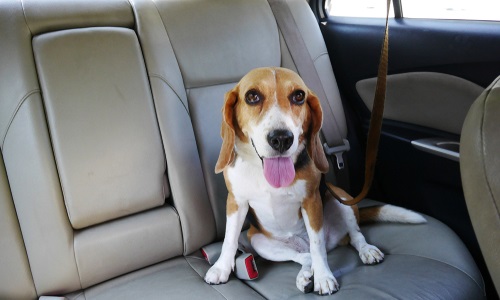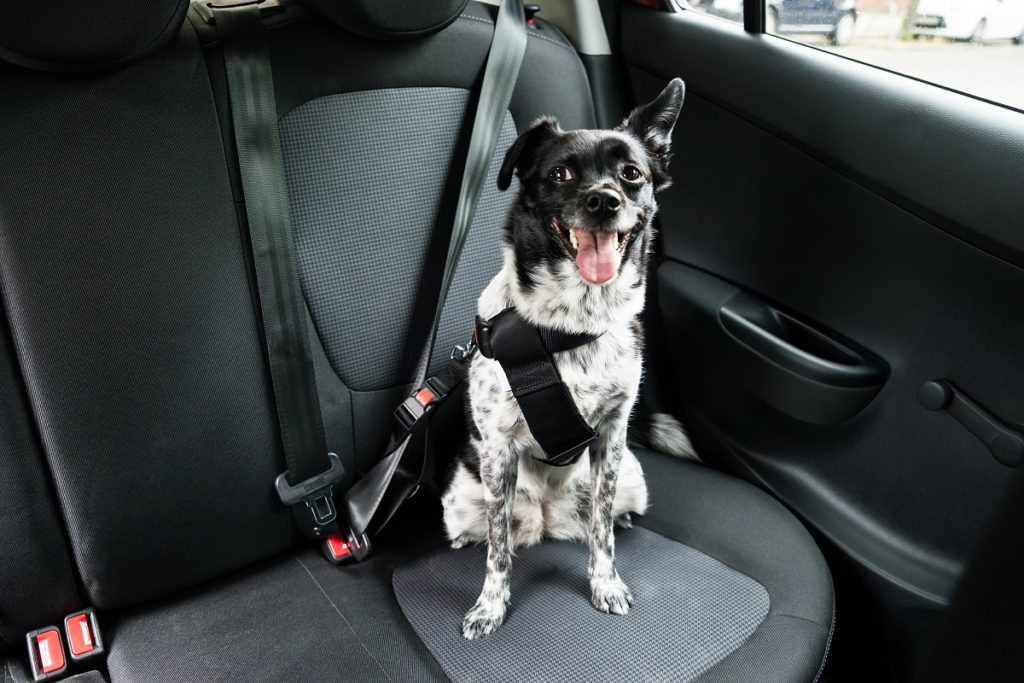Have you ever thought about a seat belt for your dog? For you it’s a no-brainer, right? If you’re heading out in the car one of the first things you do is buckle up. You understand that a seat belt is how you keep yourself safe in the event of an accident. It’s almost second nature at this point. But what many dog owners don’t realize is that when traveling with their pup, dog seat belts can actually save their furry friend’s life in the case of an accident. Not buckling up your pup can actually put you both in danger should an accident occur. Keep reading to learn more about how dog seat belts work, if these dog seat belts are safe and additional tips for driving with a pup.
There’s several reasons why not buckling up is dangerous for both you and your dog:
- During an accident or collision with another vehicle, your unrestrained dog can fall from his spot, causing injury to himself or to the driver.
- If your dog sits up in the front seat, the airbag can deploy and cause him serious harm.
- If he loves to stick his head out of the window external debris could injure him.
- If your dog sees something distracting outside, he could even try to lead out the window.
Of course, thinking about the worst case scenario isn’t fun, but it could happen and it’s best to be prepared. You can still make this a fun trip for him, even with the doggie seat belt. Special seat belts and car seats allow your dog to remain firmly in place and check out all the scenery while riding along. Having your pup buckled up also prevents any distractions for the driver. They can even help with your pet’s car sickness. If you do not own a doggie seat belt yet, you can also crate your dog to keep him safe and secure during your journey. These crates and carriers should be firmly anchored with a seat belt to ensure they don’t move around the vehicle.
How Do Dog Seat Belts Work?
So how do they work? A dog seat belt locks into the existing seat belt of your car and keeps your dog secure form moving while on the road. A well-fitted seat belt will restrain him and prevent abrupt movement. A dog seat belt can also be referred to as a harness. Since your dog may be unfamiliar to this harness at first, make sure you test it out before going on a ride.
 The car belt attaches to the back of your dog’s safety harness using a clip. It should fit secure and snug, but not too tight – you should be able to fit two fingers in between his collar the body of the harness. In the event of a sudden change of speed, the harness should spread out the force of a leash along his chest and back, and minimize force along the neck. A seat belt may not be the best option for really small dogs or toy breeds, but talk to your vet to find the best safety option for your specific pet.
The car belt attaches to the back of your dog’s safety harness using a clip. It should fit secure and snug, but not too tight – you should be able to fit two fingers in between his collar the body of the harness. In the event of a sudden change of speed, the harness should spread out the force of a leash along his chest and back, and minimize force along the neck. A seat belt may not be the best option for really small dogs or toy breeds, but talk to your vet to find the best safety option for your specific pet.
Some other safe travel tips for driving with your dog:
- Be sure to bring along water and a bowl, especially during the warmer months. Summer travel with your pup means that you’ll need to take some special precautions.
- Many dogs can even experience anxiety during a trip in the car, so be sure to get him acclimated before taking a long trip.
- Don’t get distracted. Even if he’s crying or unhappy being buckled up in the back – resist the urge to reach back and pet him. This shows to him that these actions will get him attention. Not to mention the fact the it takes your eyes off the road.
- Never leave your dog alone in the car, even if you’ve cracked the windows. Both extreme cold and heat can be dangerous.
- Invest in a dog safety kit that you can keep in your car. It can include an extra leash and collar, blanket, toys, food, water, poop bags and even a first aid kit.
Remember, your dog is the safest when he’s secured in place and protected. It’s not safe for him to be jumping around the car or hanging out the window. Also remember that the safest spot for your dog is in the back seat. Of course, he shouldn’t be up front without being fastened in place – but it’s not safe for him to be up front at all. Even with a dog seat belt, he should still be secured in the back.
With a little patience and a couple of adjustments, your dog is well on his way to becoming a better riding partner and of course, a safer one. Just remember that it will take time to change your dog’s habits, especially in older dogs. Keep rewarding him every time they do well.
Sources:
- “Dog Car Seats and Seat Belts: Can They Keep Your Pup Safe?” PetMD, 19 Feb. 2019, www.petmd.com/dog/care/dog-car-seats-and-seat-belts-can-they-keep-your-pup-safe.
- Geier, Elisabeth. “How to Keep Your Dog Safe in the Car (Hint: Buckle Up!).” Rover, 22 Feb. 2019, www.rover.com/blog/dog-car-seat-belts/.
- “Do Pet Seat Belts Really Work?” Dogtime, 26 Aug. 2015, www.dogtime.com/how-to/pet-safety/16426-do-pet-seat-belts-really-work.




